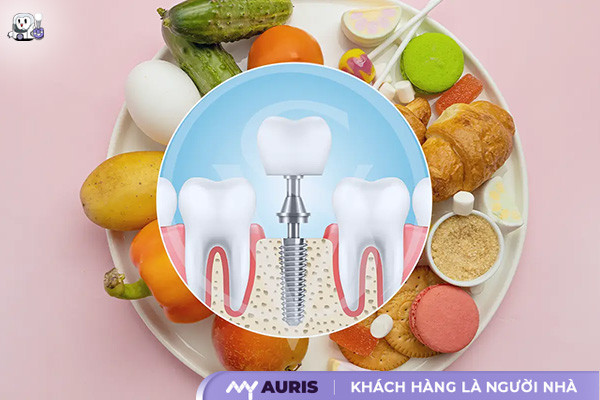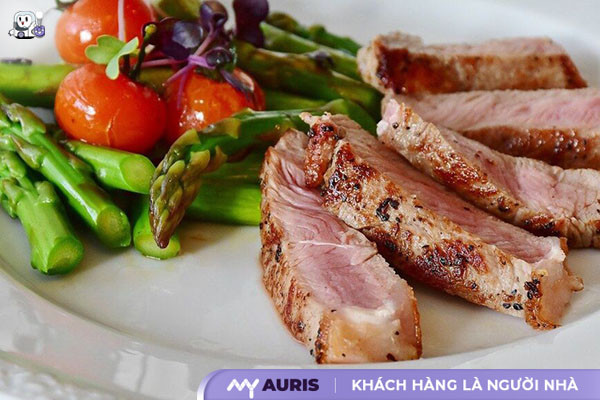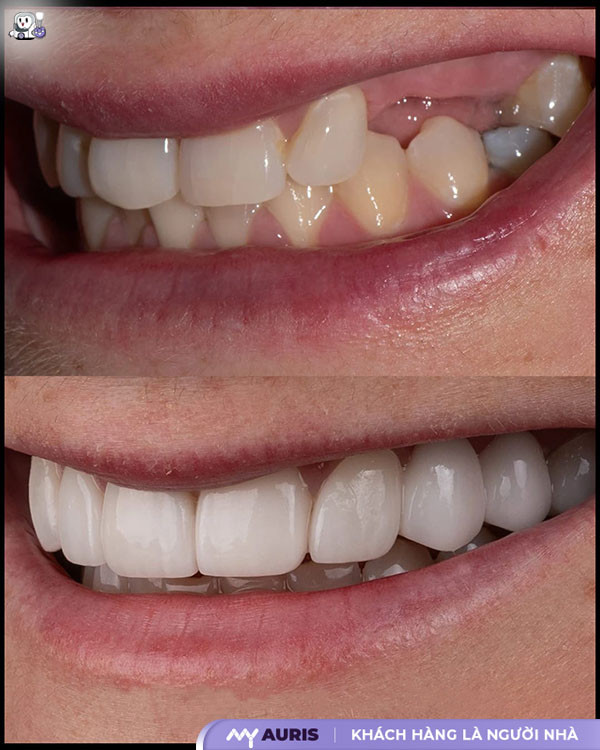The diet after dental implant placement is a crucial factor determining the success of the grafting procedure. Eating appropriately helps reduce the risk of infection and promotes faster healing. So, what should people who have just received dental implants avoid and what should they eat? My Auris Dental Clinic will provide detailed advice in the following article!
What to eat after dental implant placement?
Choosing the right food groups after dental implant placement plays a crucial role in the recovery process. An appropriate diet helps limit impact on the newly implanted area, reduces pain, and enhances healing ability.
Prioritize soft and liquid foods
In the first few days after implant placement, patients should consume soft and liquid foods such as porridge, soup, etc. These foods are easy to swallow, require minimal chewing, and help patients avoid extensive jaw movement, thereby reducing pressure on the implanted area. As a result, patients will feel more comfortable, experience less pain, and their wounds will heal faster.
Vitamin D-rich foods
In the diet after implant placement, patients should prioritize supplementing with Vitamin D-rich foods such as fish, eggs, and milk. This nutrient is essential for efficient calcium metabolism, thereby maintaining strong bone structure and accelerating the osseointegration process between the jawbone and the titanium implant post. Vitamin D, along with other vitamins and minerals, plays a crucial role in post-operative nutrition, supporting bone health and enhancing osseointegration during dental implant procedures. Therefore, choosing the right Vitamin D-rich foods not only aids in better post-operative care but also improves the effectiveness of implant placement.
Fruits
Fruits such as grapefruit, oranges, strawberries, avocados, bananas, blueberries, raspberries, pomegranates, plums, and grapes are excellent choices due to their richness in essential vitamins and minerals. This food group not only effectively reduces inflammation but also promotes faster wound healing, boosts immunity, thereby limiting fatigue, weakness, and minor illnesses during the recovery period. Incorporating a variety of fruits into the daily diet is a simple yet effective solution to naturally improve overall health.
Vegetables
Vegetables such as cauliflower, potatoes, carrots, broccoli, various beans, bell peppers, and green leafy vegetables are highly nutritious foods, especially rich in numerous vitamins (A, B, D, K, E) and essential minerals like Folate, Iron, Phosphorus, Potassium, Magnesium, and Calcium. Thanks to this abundant nutrient content, vegetables not only help restore energy quickly but also contribute to strengthening the jawbone. Additionally, proper vegetable intake supports accelerated wound healing, improves overall health, and naturally boosts immunity.

What to avoid eating after dental implant placement for optimal recovery and to prevent complications?
For a smooth healing process after dental implant placement, patients need to pay special attention to their diet. One crucial factor for the titanium post to achieve biological compatibility with the jawbone is maintaining a reasonable integration period and limiting foods that could potentially affect the implanted area.
Avoid excessively chewy and hard foods
Immediately after implant placement, the titanium post needs time to stabilize within the jawbone for a strong connection. Foods that are too chewy or too hard, such as beef jerky, baby back ribs, grilled rice paper, etc., can easily create strong biting, chewing, and tearing forces, prolonging recovery time, reducing implant stability, causing pain, and posing a potential risk of complications. Therefore, in the initial post-operative phase, patients should choose soft, easy-to-swallow foods and limit chewing in the implanted area.
Avoid excessively sour and spicy foods after implant placement
After implant placement, the unhealed wound is very susceptible to irritation if excessively spicy foods are consumed, leading to a burning sensation, discomfort, and pain in the implanted area. Additionally, avoiding overly sour foods is also crucial because the sour taste can cause tooth sensitivity and gum irritation, affecting the recovery process.
Limit foods with excessively hot or cold temperatures
Inappropriate temperatures can prolong implant healing. Consuming foods that are too hot or too cold can not only cause tooth sensitivity but also lead to prolonged bleeding from the wound and affect the stability of the implant. Therefore, it is advisable to limit hot and cold foods throughout the recovery period.
Do not drink alcohol, beer, or carbonated beverages
One important thing to remember is to refrain from consuming alcohol, beer, and carbonated beverages for at least 4 weeks after implant placement. These types of drinks can prolong healing time, increase susceptibility to infection, and even affect adjacent teeth. Abstinence after implant placement helps optimize treatment outcomes and avoid long-term risks.

Suggested standard diet for each stage of dental implant placement
For a smooth and optimal dental recovery process, patients need to establish a standard diet tailored to each stage of dental implant placement. Below is a detailed guide for the initial period after implant surgery:
The first 1,440 minutes (24 hours)
During the first hour after implant placement, patients should not eat and need to limit chewing activities to avoid affecting the surgical area. For the next 23 hours, they can start consuming liquid foods such as porridge, soup, etc. However, it’s crucial to prevent food from touching the wound and limit sticky foods to reduce the risk of infection or damage to the implanted area.
Stage 2 – 3 days after tooth implantation
During the 2 – 3 days following tooth implantation, the implanted area begins the healing process. Therefore, patients should continue to maintain a soft diet similar to the first day. Simultaneously, supplement with vegetables and fruit juices to provide essential nutrients that aid in effective body recovery.
During this time, patients should strictly avoid chewy foods, hard foods, and foods that are excessively cold or hot, as these can irritate the implanted area, increasing the risk of inflammation or damage. Strict adherence will help prevent complications and support the tooth implantation process in achieving the best results.

The next 2 weeks after implant placement
During the next 2 weeks after implant placement, if the patient has followed the standard diet in the initial days, the wound should now be stable, pain should have almost disappeared, and discomfort significantly reduced. The patient can eat as usual, but should still prioritize soft, easy-to-chew foods to avoid putting pressure on the implanted area. Although the wound may appear healed externally, it is not yet fully integrated, so it is absolutely essential not to use the tongue, hands, or any object to touch the implant site to prevent damage to the healing tissue.
Many patients also wonder if they can eat chicken after implant placement. The answer is yes, but the chicken must be soft and shredded into small pieces for easy chewing, to avoid affecting the implant site.
In parallel, patients need to maintain regular oral hygiene and schedule follow-up appointments as directed by their dentist. If any unusual symptoms occur, such as prolonged swelling or pain, bleeding, or a feeling of a loose tooth, contact the dentist promptly for treatment.
To limit unwanted risks and complications, patients should choose a reputable dental clinic with a team of experienced doctors. Because dental implant placement is a complex procedure, if the dentist’s skill is not strong, incorrect technique can lead to swelling, inflammation, bleeding at the implant site, difficulty in implant integration with the jawbone, or even looseness, causing damage to nerves and adjacent tissues.
Proper care during this period plays a vital role in the recovery process and determines the long-term success of the implant procedure.





